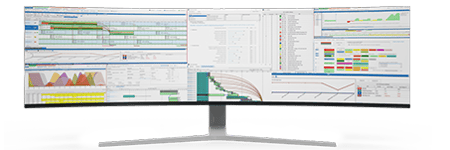Improving Inventory Management in Packaging Manufacturing
Managing inventory effectively is crucial to maintain product flow, control costs, and meet customer demands in packaging manufacturing. Yet, inventory management is also one of the most challenging aspects of the supply chain, often plagued by issues such as excess stock, stockouts, and inefficient use of storage space.
Integrating a robust production planning solution like PlanetTogether with leading ERP systems like SAP, Oracle, Microsoft, Kinaxis, or Aveva can help supply chain managers streamline inventory processes, improve accuracy, and enhance overall operational efficiency.
This blog will explore the benefits of an integrated approach to inventory management, the role of PlanetTogether in simplifying complex production workflows, and how connecting it with your ERP can bring data-driven insights that transform inventory management in packaging manufacturing.

Inventory Management in Packaging Manufacturing
Inventory management in the packaging industry is more intricate than many realize. Packaging materials vary in size, shape, material, and durability, and often have short lead times and demand spikes. Additionally, customer-specific requirements can lead to complex inventories with varied items such as custom labels, specialized containers, and unique designs.
Balancing inventory levels is crucial to avoid both overstock and stockouts. Overstock ties up capital and increases storage costs, while stockouts can disrupt production and erode customer trust. Without precise visibility into current inventory levels, consumption rates, and order demand, supply chain managers may face reactive, rather than proactive, inventory decisions.
With PlanetTogether and a connected ERP system, manufacturers can transition from reactive to predictive inventory management.
![]()

Integrating PlanetTogether with ERP Systems for Real-Time Inventory Insights
PlanetTogether is a powerful advanced planning and scheduling (APS) tool that optimizes production schedules, resource allocation, and inventory management. By integrating it with ERP systems like SAP, Oracle, Microsoft, Kinaxis, or Aveva, companies gain end-to-end visibility into inventory data, order workflows, and resource utilization.
An integrated approach offers several key benefits:
Enhanced Visibility
PlanetTogether, when linked to an ERP system, provides real-time visibility into inventory levels, making it easier to track inventory usage against production schedules. For example, if the ERP system records an incoming materials delivery, PlanetTogether can immediately account for it in scheduling and production plans, ensuring there’s no lag in updates.
Accurate Demand Forecasting
Inventory planning can only be as effective as the data it’s based on. Integrated ERP and APS systems can process historical data, seasonality, and real-time order flow to forecast demand accurately. For example, Microsoft’s demand forecasting features can work in sync with PlanetTogether to align inventory levels precisely with production schedules, thereby avoiding excess stock or shortages.
Efficient Lot and Batch Tracking
Many packaging manufacturers handle lots and batches of materials with limited shelf lives or specific quality standards. By integrating PlanetTogether with systems like Aveva, supply chain managers gain seamless traceability for lot tracking, ensuring that materials are used within expiration dates, reducing waste, and maintaining compliance.
Automated Inventory Adjustments
As production schedules and resource allocations adjust in real-time within PlanetTogether, inventory levels are automatically updated in the ERP system. This continuous flow of information eliminates manual adjustments, reduces human error, and provides precise insights into available inventory.
Optimized Replenishment Processes
Integration with ERP platforms like SAP allows for automatic inventory reorder triggers when supplies reach minimum thresholds. Combined with PlanetTogether’s demand planning, this process optimizes reorder quantities to avoid overstocking, creating an efficient replenishment cycle that aligns with actual production needs.

Practical Steps for Effective Inventory Management with PlanetTogether and ERP Integration
For supply chain managers aiming to leverage these tools for enhanced inventory management, here are several actionable steps:
1. Establish Real-Time Inventory Synchronization
Synchronization between PlanetTogether and your ERP system should be seamless and real-time to maintain accuracy. For example, with Oracle’s real-time data capabilities, every inventory update is instantaneously shared with PlanetTogether, ensuring that your production schedules are based on current stock data.
Implementing real-time synchronization enables the ERP system to track every production order, material movement, and stock change as it happens. This approach reduces delays and enhances accuracy, critical in environments where inventory can be a costly bottleneck.
2. Implement Safety Stock and Reorder Thresholds
Safety stock acts as a buffer for unexpected spikes in demand or delays in supply. With integration, PlanetTogether can assess historical data and seasonal trends to establish more accurate safety stock levels, automatically updating reorder points within your ERP. Tools like Kinaxis offer real-time scenario planning that helps refine safety stock levels, balancing the need to minimize stockouts without inflating inventory holding costs.
By setting automated alerts in the ERP system, supply chain managers are notified as soon as inventory hits these thresholds, enabling proactive ordering without overshooting.
3. Utilize Demand Planning and Inventory Forecasting Features
By integrating ERP and PlanetTogether, supply chain managers can perform accurate demand planning and inventory forecasting. Microsoft’s Dynamics 365, for instance, offers predictive analytics capabilities that can forecast demand patterns based on historical data. This demand data flows into PlanetTogether to adjust production schedules accordingly, leading to better alignment of inventory levels with real production needs.
The forecasting capabilities not only enable manufacturers to meet customer demand more effectively but also help reduce waste, minimize costs, and improve overall customer satisfaction by reducing lead times.
4. Streamline Production Scheduling for Better Inventory Flow
Production scheduling directly impacts inventory flow. With PlanetTogether’s detailed scheduling capabilities, supply chain managers can create an optimized schedule that reduces idle time and prevents bottlenecks. When connected with SAP, for example, production adjustments made in PlanetTogether are immediately reflected in inventory needs, ensuring a smoother inventory flow that aligns with production.
This connection enables demand-driven manufacturing by aligning production schedules with inventory flow, ensuring that materials are utilized efficiently and kept at optimal levels throughout production cycles.
5. Optimize Lot Sequencing and Expiry Management
In packaging manufacturing, where certain materials may have expiration dates, integrating with PlanetTogether can support optimized sequencing that respects these constraints. Aveva’s batch tracking and shelf-life monitoring capabilities can synchronize with PlanetTogether to prioritize material usage based on expiry dates, reducing wastage due to expired inventory.
An integrated system helps track lot numbers and expiry dates from receiving through to production and shipping, enabling better control and compliance for quality-sensitive packaging operations.
Integrating PlanetTogether with a robust ERP system like SAP, Oracle, Microsoft, Kinaxis, or Aveva enables packaging manufacturers to tackle inventory challenges with data-driven precision. Supply chain managers benefit from real-time visibility, automated adjustments, and optimized scheduling, creating a leaner, more efficient inventory management process.
In a competitive market where agility and responsiveness can make or break success, an integrated approach empowers packaging manufacturers to meet demand, minimize waste, and maximize resource utilization. By investing in the right tools and leveraging the power of integration, supply chain managers can elevate their inventory management strategies, paving the way for a more efficient and cost-effective supply chain.
Are you ready to take your manufacturing operations to the next level? Contact us today to learn more about how PlanetTogether can help you achieve your goals and drive success in your industry.
Topics: PlanetTogether Software, Accurate Demand Forecasting, Integrating PlanetTogether, Improved Order Fulfillment Rates, Enhanced Compliance and Traceability, Packaging Manufacturing, Reduction in Stockouts and Overstock, Lower Inventory Carrying Costs, Efficient Lot and Batch Tracking




















LEAVE A COMMENT